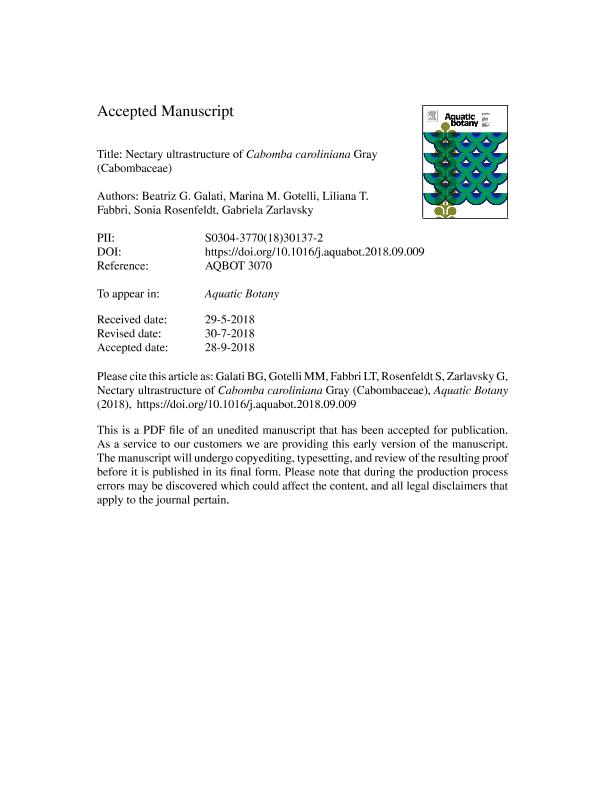Artículo
Nectary ultrastructure of Cabomba caroliniana Gray (Cabombaceae)
Galati, Beatriz Gloria; Gotelli, Marina María ; Fabbri, Liliana Teresa; Rosenfeldt, Sonia; Zarlavsky, Gabriela Elena
; Fabbri, Liliana Teresa; Rosenfeldt, Sonia; Zarlavsky, Gabriela Elena
 ; Fabbri, Liliana Teresa; Rosenfeldt, Sonia; Zarlavsky, Gabriela Elena
; Fabbri, Liliana Teresa; Rosenfeldt, Sonia; Zarlavsky, Gabriela Elena
Fecha de publicación:
01/2019
Editorial:
Elsevier Science
Revista:
Aquatic Botany
ISSN:
0304-3770
Idioma:
Inglés
Tipo de recurso:
Artículo publicado
Clasificación temática:
Resumen
Cabomba Aubl. is a genus considered as a potential genetic model for studies of early angiosperm evolution, accordingly, it is important to expand the knowledge of it. This paper reports the study of the anatomy and the ultrastructure of the nectary of Cabomba caroliniana Gray using bright-field microscope, scanning and transmission electron microscope in order to understand its secretion mechanism. C. caroliniana has protoginous flowers and the anthesis lasts two days. Nectaries of C. caroliniana are located in two basal lobes or yellow auricles of each white petal. Most nectar is observed in the area above the pronounced auricles. The secretion is released mainly by the four-cellular trichomes or hydropotens present in both nectary epidermis. The cellular ultrastructure indicates that the nectary is active during the two days of the anthesis. This agrees with the fact that in both anthesis days the fertile structures of the flower (first the stigmata and then the anthers) are disposed above the nectaries. The nectar secretion mechanism is discussed in relation to the present knowledge. The results of this study are related to what has been described for other basal angiosperms.
Palabras clave:
CABOMBA
,
HYDROPOTENS
,
NECTARY
,
ULTRASTRUCTURE
Archivos asociados
Licencia
Identificadores
Colecciones
Articulos(OCA PQUE. CENTENARIO)
Articulos de OFICINA DE COORDINACION ADMINISTRATIVA PQUE. CENTENARIO
Articulos de OFICINA DE COORDINACION ADMINISTRATIVA PQUE. CENTENARIO
Citación
Galati, Beatriz Gloria; Gotelli, Marina María; Fabbri, Liliana Teresa; Rosenfeldt, Sonia; Zarlavsky, Gabriela Elena; Nectary ultrastructure of Cabomba caroliniana Gray (Cabombaceae); Elsevier Science; Aquatic Botany; 152; 1-2019; 43-50
Compartir
Altmétricas



